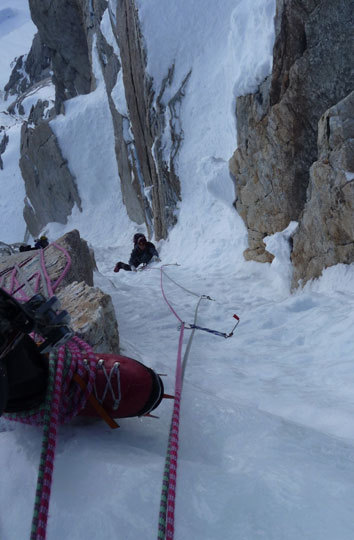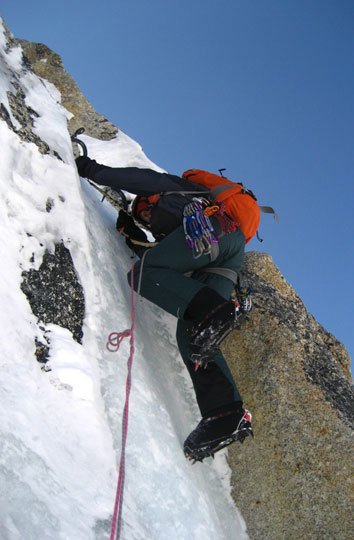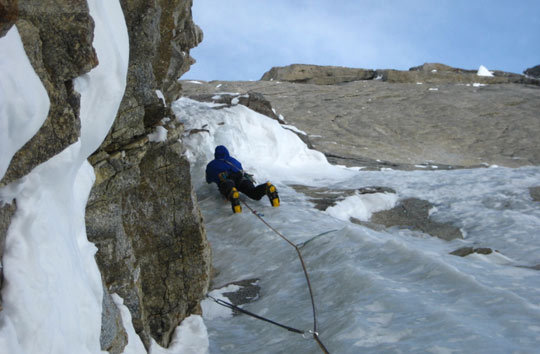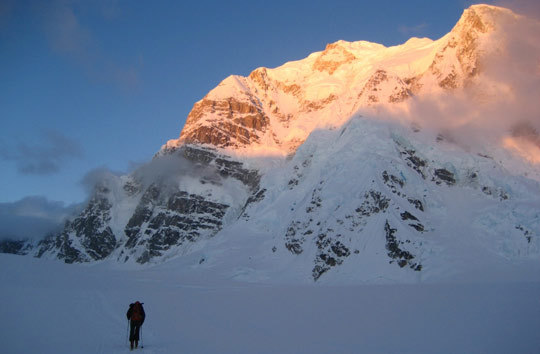Earlier this season, I traveled along with five other Slovenians–Ambroz Bajde, Ales Kozelj, Urban Novak, Aljaz Tratnik, Davor Velikanje–to the Alaska Range. We tried to spend time on both Mt. Foraker and Denali, the cradle of alpinism’s future: quick, single-push ascents with minimal gear.

Urban Novak climbing on Deprivation (Alaska Grade 6: ED+ 90 degrees, ca. 6000′, Backes-Twight, 1994), Mt. Hunter, Alaska Range, Alaska. This spring Novak and five other Slovenians, though not successful in climbing any new routes, ticked a handful of Alaska Range classics. [Photo] Matej Kladnik
We reached the Kahiltna glacier on May 24, 2008, set up base camp and headed for Mt. Hunter on skis. From there, we established that the climbing conditions looked good. To acclimatize, Tratnik, Velikanje, Bajde and Kozelj climbed the rocky and snowy southwest ridge (IV 5.8 60 degrees, 3,600′) of Mt. Frances. The same day, Novak and I climbed the North Couloir (IV 85 degrees, 2,000′) on Mini-Moonflower and came across very hard, dry ice. We expected interesting climbing on the 85-degree pitch, but the ice was too thin to try, so we took the overhanging left variant and climbed to the ridge, avoiding the cornice.
During the next few days we rested and prepared for Mt. Hunter. On May 30, Bajde and Kozelj were the first to start the Grison-Tadeshi route, also known as the French Route (Alaska Grade 6: M6 90 degrees, 1500m). They climbed the couloir in the lower part of the wall quite quickly. This feature is situated near the so-called Ice Face on the west ridge, the route taken by the first ascensionists to reach the summit. Traverses in the middle of the route slowed them down, and the most challenging part was the upper section, where they encountered some difficult mixed pitches. They summited Hunter and descended its long west ridge. Due to bad weather conditions, namely fog and snow, they couldn’t orient themselves–limited visibility caused them to change plans and descend through the couloir under seracs with the help of ropes. The descent took nine hours; the entire climb, from base to base, lasted fifty-six hours.
The rope team Tratnik-Velikanje was the first to get on Deprivation (Alaska Grade 6: ED+ 90 degrees, ca. 6000′, Backes-Twight, 1994), and Novak and I followed an hour later. In the lower part we faced a steep climb with rather poor protection at times. We had to climb the steep snow that had been blown against the wall, which made any effective belay nearly impossible. Avalanches of powdery snow made climbing even more difficult, and a couple demanding sections of rock offered some challenges. In the early evening, we had a short break and continued on that night.
Due to poor weather conditions, we reached the upper snowfield via the North Buttress route, the same as the first repeaters, and continued to the Corny bivouac. When we were a pitch above the bivouac, we decided that due to the bad weather–almost zero visibility because of snow and fog–we would not attempt to reach the summit. We instead descended across the wall, down the route that had a few fixed anchors instead of via the difficult West Ridge. The descent took fifteen hours, and the whole base-to-base climb took forty-six hours. The following few days we spent resting and drying our equipment at BC.

Ales Kozelj leading up the French Route (Alaska Grade 6: M6 90 degrees, 1500m), Mt. Hunter, Alaska. [Photo] Matej Kladnik
On the evening of June 6, we left for Denali base camp on skis. After a five-hour trek, wind and snow forced us to set up a camp in the middle Ski Hill, halfway to Denali. Still fighting the bad weather conditions, we reached the 11,000′ camp the next day. After a day of rest, the weather forecast still did not look promising, so Bajde, Kozelj, Tratnik, Velikanje and Novak decided to take the easiest route to climb Denali (6194m), the West Buttress. They summited around midnight in severely cold weather and descended to the tents immediately. Meanwhile, I spent time skiing.
In difficult weather conditions, the other five climbers returned to the air base the day after descending Denali and took a flight to Talkeetna. Urban and I remained on the glacier and set up camp in the vicinity of Kahiltna Peak (12,835′). We wanted to climb the couloir in the right section of Kahiltna Peak’s south wall. At its base we realized that the serac was too close to the couloir’s access point. For the sake of safety, we gave up and returned to our tent, then went to the air base the following day. At the end of the expedition, Novak and I climbed the southwest ridge of Mt. Frances–the mountain that the rest of our team had climbed at the beginning of the expedition. The following day, on June 16, we headed for Talkeetna. We met with the rest of the expedition members in Anchorage, where we spent two days before returning to Slovenia.

Novak ascending the North Couloir (IV 85 degrees, 2,000′), Mini-Moonflower, Mt. Hunter, Alaska. [Photo] Matej Kladnik
Alaskan mountains are a destination that many alpinists dream about, as they are as challenging as the Himalayas. Long walls and approaches, quick changes of weather and rugged glaciers make climbing in Alaska a unique experience–the only thing missing is the high elevation of the Himalayas. And during my visits to Alaska, I realized that both visitors and locals were kind and willing to communicate and share, yet another reason why I look forward to visiting Alaska again.

Mt. Hunter, Alaska. [Photo] Matej Kladnik collection